A planned 300-kilometer Nicaraguan canal joining the Pacific and Atlantic Oceans could wreak environmental and cultural ruin, home of the Miskitu and other indigenous groups. Sam Gordon argues that many of the issues and impacts are hidden from public view and should require an independent environmental assessment. Sign the petition to stop it…click here.
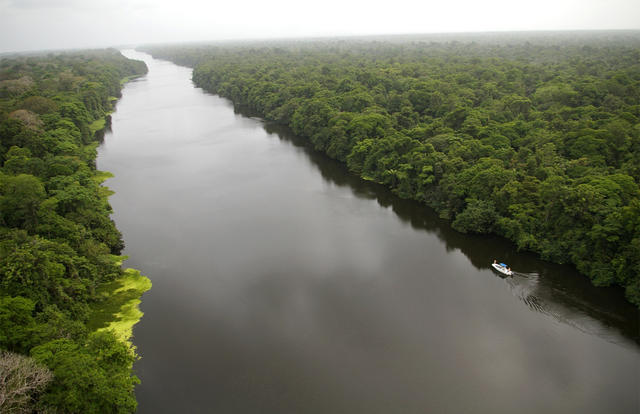

Under the Table: The Grand Canal of Nicaragua
By Sam Gordon, Published in CounterPunch
It´s getting close to that time of year again. Sometime soon a vicar of the Anglican Church will write to the Times of London announcing that he or she has heard the call of a cuckoo, deep in the English shires. Such bird song is said to announce the arrival of summer.
The cuckoo´s call is also a signal for journalists that the silly season is upon us; frivolous stories can get the editor´s blessing. Articles that would have been spiked at any other time of year make it into print.
Nicaragua approves route for $40 billion canal linking oceans. — Reuters
I recalled this as I scanned the world´s news outlets for word on the proposed Grand Canal of Nicaragua. This water way, which doesn’t yet fully exist, holds the possibility of creating a deep sea shipping route linking the Atlantic and Pacific Oceans. Nicaragua, besides having a Caribbean and a Pacific coast line, has the largest fresh water lake in the whole of Central America. And it doesn´t have the inconvenience of awkward mountain ranges between the lake and the oceans.
The Nicaraguan Canal threatens multiple autonomous indigenous communities such as the Rama, Garifuna, Mayangna, Miskitu and Ulwa, and some of the most fragile, pristine and scientifically important marine, terrestrial and lacustrine ecosystems in Central America. — Axel Meyer and Jorge A. Huete-Pérez, “Nature”
For centuries this topography has been the stuff of dreams. For some economists it spells comparative advantage. Lake Nicaragua (or Cocibolca), in the center of the country, is a readymade canal gifted by nature to the people of this impoverished country. For others, including a good many ecologists, it is a risk far beyond reason.
STORY: Costa Rica: Conservationists Face Corruption and Drug Trafficking
A Sweetheart Deal: Selling National Sovereignty and Natural Resources
Around the turn of the year the media buzz in Nicaragua was taken up by talk of an agreement about this venture between President Daniel Ortega and a Chinese telecom mogul, Wang Jing of the HKND Group. Talks have now taken place and studies are already in motion to determine the best route for the canal. Different approaches to and from the lake are under in-house consideration. And the International Longshore and Warehouse Union claims that Russia is looking for ways to become involved. Despite this considerable uncertainty a figure of US$ 40 billion is the confidently quoted cost.
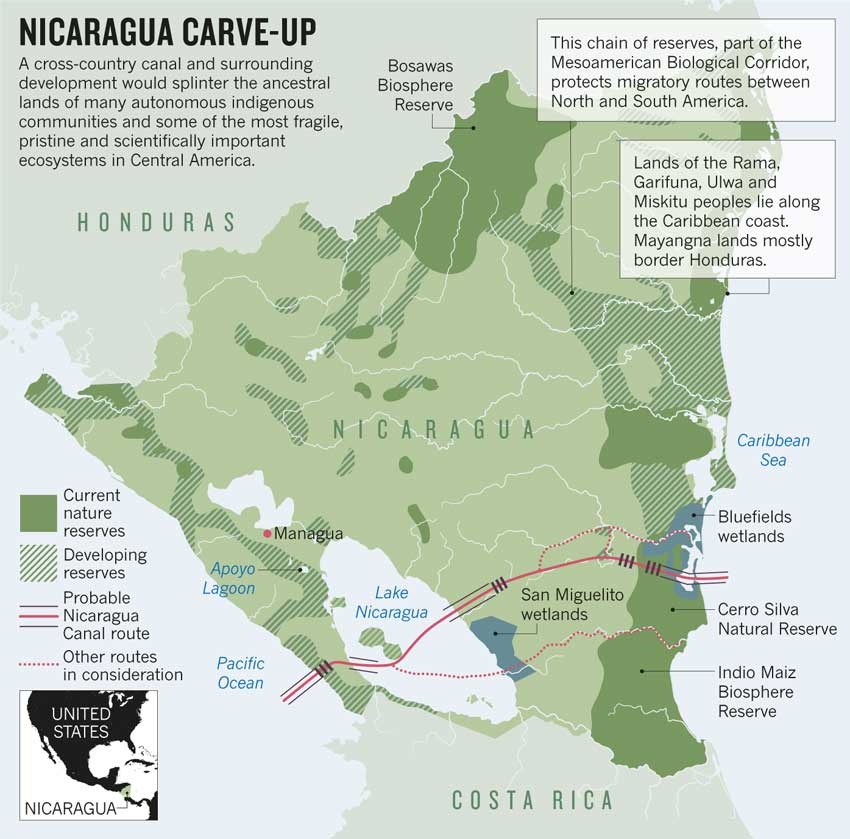

Now imagine my surprise when reading in British newspapers that the Chinese are proposing a 13,000km (around 8,080miles) high speed rail link. Forget linking two oceans. This jaunt will take in China, stopping at Russia and Canada before pulling into the USA. For those not familiar with the geography that means crossing; well, tunneling under, the Bearing Sea between Siberia and Alaska.
We are all familiar with casino banking nowadays, so why be alarmed at gaming in the transportation industry?
So far we know there is a stake holder at the table called Grand Canal of Nicaragua. Word has it that another player is on his way, via a very long rail link. But history has already dealt out some of the deck to regular players in this game of chance. Who are they?
A Long History of Canal Dreaming
Italian born John Cabot sailed from England toward the end of the 15th century, hoping to find the North West Passage, a sea way linking the north Atlantic and north Pacific. He had in mind a route north of Newfoundland and south of Greenland which would eventually lead him to Japan. But that turned out to be his last voyage, he was never seen again.
Then the Portuguese Ferdinand Magellan sailed between the southern main land of South America and the island of Tierra del Fuego while sub contracted to the King of Spain in 1520. Although the Tehuelche and other indigenous people had likely paddled their canoes through the same passage long before Europeans arrived on the scene.
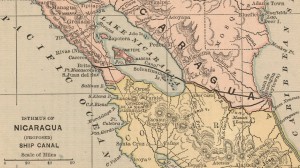

The 1848 California gold rush saw this southern passage become a busy place for shipping, carrying hopeful prospectors from the east and heading west. Then, Nicaragua made it onto the map of the world´s trading routes. There was no need to hit the wagon trail across the North America continent nor sail the far off southern seas. A relatively short sea voyage down the east coast of North America to Nicaragua´s San Juan River, followed by a stagecoach journey to the country´s Pacific coast, then a sail from Grenada going north to California was sufficient.
While Europe went to war in 1914, the US opened the Panama Canal for international shipping traffic. Before that the French had tried and failed, beaten largely by the forces of nature. A few years before the US had provoked civil disturbances in northern Colombia resulting in that country´s northern region of Panama declaring itself an independent republic. One JP Morgan became the fiscal agent of the new Republic of Panama and arranged the transfer of US$ 40 million for the right to build and a few other concessions.
Predictably, over the hundred years since the canal opened the size of ships has increased dramatically, as ship owners seek to gain economies of scale in the transportation of cargoes. Responding to this, Panama, in conjunction with a European consortium, is in the process of expanding the capacity of the canal by building an additional third set of locks to the original two sets. This and other engineering works will increase the size and number of ships using the canal.
While this is all good 21th century stuff the 15th century notion of using the North West passage is making a comeback. That´s entirely due to climate change. As the Arctic polar ice cap recedes the likelihood of year round commercial inter oceanic shipping advances and the North West Passage opens for business. Last year CBC News reported that 19 vessels had registered with the Canadian Coast Guard to make the transit. That´s a small number but the route must look favorable to the industrialized traders of northeast Europe and the emerging economies of northern Asia.
STORY: Model Cities: Neo-Colonialists Seek Submissive Wild For Capitalist Utopia
A High-Stakes Game of Trade and Global Control
So the real players in this game of chance, besides the Grand Canal of Nicaragua, are: Expanded Panama Canal, the resurrected novice North West Passage, and the maverick China Russia Canada America Line. As you might expect in this latter day Malamute Saloon there are a number of onlookers. Depending on how the deck is dealt lies their future and fortune.
On the southwestern side of Nicaragua, cited as the canal´s contact point with the Pacific there is considerable wealth. Some of it is long standing, some of it is new money, some of it is domestic, much of it comes from outside Nicaragua. Whatever the impact of the canal, its envisaged air, rail and road terminals with associated services, those with the money will not be in want. They can stay or move. However, the opportunity of employment with useful skills for poor local people cannot be discounted.
Lake Nicaragua would also serve as the reservoir for the canal’s lock system, requiring dams to be constructed in an area of frequent seismic activity, which would increase the risk of local water shortages and flooding. The lake would probably suffer from salt infiltration in the lock zones, as in locks of the Panama Canal. This would transform a free-flowing freshwater ecosystem into an artificial slack-water reservoir combined with salt water. Declining populations of native aquatic fauna such as euryhaline bull sharks, sawfish and tarpon, important for sport fishing and tourism, could also suffer. — Meyer and Huete-Perez
The Caribbean side of Nicaragua does not have the same intensity of wealth and level of development as the Pacific. Nevertheless, the Caribbean culture enriches the country´s diversity, yet far from being economically that well integrated at a national level. The impact of an improved infrastructure with support services, similar to the Pacific side, is heralded as a significant and positive socio-economic driver.
A Virgin Forest, Indigenous Sovereignty
But between these coast lines and to the east of the Cocibolca, lies a virgin, forest wilderness. Does that sound too bland? The international journal Nature (19 April 2014) describes it differently.
“. . . the ancestral lands of many autonomous indigenous communities and some of the most fragile, pristine and scientifically important ecosystems in Central America.”
What the scientists have done in this article is to introduce the concept of value into what might otherwise be described as a crap game. So let´s rummage about for some tools – analytical frame works if you prefer -among Karl Marx´s kit. His ideas of “use value” and “exchange value” will do for starters.
The southern Caribbean coast is not without urbanization. The city of Bluefields has two universities. Nevertheless, in this so called wilderness live people, in disperse and family based rural communities, who lead lives in which use value is a major element. They cut trees to build homes. They gain protein from fish in the river systems that feed the lake and the few animals they husband. The land they till provides their families with grains and vegetables. These are commodities they use. Their neighbors have much the same so there is little value in exchange.
Of course the zone is not totally without trade. When they can, people do buy and sell products at market. Such goods as plastic sheeting and corrugated iron for house building, basics like salt and sugar, not to mention medicines and school books are on offer, sold and bought.
Instead of commissioning an independent environmental study of its own, the Nicaraguan government will rely on one contracted out by HKND to a U.K.-based global consulting firm, Environmental Resources Management. HKND is under no obligation to make public the results.
But theirs if a life where exchange value accounts for fewer commodities than are accumulated as use value. What the canal has is the potential, indeed the certainty, of bringing exchange value increasingly into the daily lives of poor people. The details of that impact are less clear.
Change in any society or community is inevitable. But the Grand Canal of Nicaragua is a huge stake holder. What chance does the North-South America migratory routes of the Mesoamerica Biological Corridor, not to mention the ancestral lands of the Rama, Garifuna, Ulwa or Miskitu people have when faced with a US$40bn stake?
STORY: Miskitu Legend: Journey for Love into the Afterlife
Under the Table
Here in Nicaragua people use the expression “bajo la mesa” (under the table), meaning one off the bottom of the deck or some such underhand act. No independent, cultural, social or environmental impact assessment – only the in-house evaluation – is in the offing. So should we be alarmed about something bajo la mesa?
It´s not merely a question of exchange value bringing in new commodities, however beneficial, detrimental or trivial. Exchanges can and are made under the table in Nicaragua, not much different from many other places really. After all, we are dealing with the joined-at-the-hip political classes and global commercial interests, riding high on a cocktail of collaboration and unseen financial transactions. The much vaunted “invisible hand” is part of this body.
The voice of the poor goes largely unheard. But it is there and the shoots of discontent are calling out in the wilderness. The question is, will it attract sufficient domestic and international attention to let us see all the cards on and below the table?
Sam Gordon worked in a Belfast factory, then an engineer in the merchant navy, a trainer, researcher and co-coordinator of community projects in Scotland. A graduate from various universities, on a good he claims he’s a decorative artist and sometimes writer. Most days he’s a blacksmith, welder, and painter in Nicaragua.



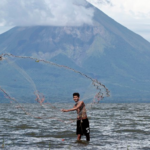
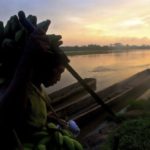
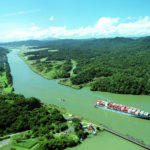
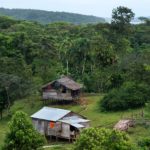






“Man of the People” — yeah, right. In the words of the Miskitu, whom I have lived with on the Atlantic Coast, he has always been a typical cutthroat Spaniard exploiter, the same breed that has been the enemy of the people of the Caribbean Coast since forever. They have not been consulted, except for maybe a few emissaries, who, as you say, are happy to take a paycheck for their “people.”
While he is clearly superior to the outright murderous presidents of both Honduras and Guatemala, his massive blind spot that created the Contra War, the under-valuing of the sovereignty of the real people of Nicaragua and his quick alliances with the enemy-of-his-enemy is everywhere in this project, and puts him and the Nicaraguan people on a path toward disaster.
For Russia and China, this is a way to subvert US hegemony once again, building a completely useless canal just so it can be theirs. The US has been investing heavily in upgrading the Panama Canal. Here is more info on the hegemonic back-and-forth from my friend Arnie Saiki from Moana Nui: The Nicaragua Canal: The New-Port Arms Race
Chris Pine wrote: So this is being proposed by that ostensible Man of the People, Daniel Ortega, and vague China interests… The political and economic elite of Nicaragua must be slobbering to make this happen with the China investors, like any Chamber of Commerce. U.S. shipping interests in the eastern gulf ports, which want to break the hold Los Angeles shipping and railroad concerns have on cargo transfer to central and eastern metropolitan areas are probably good to go, since it is not a project on U.S. soil, and not subject to our environmental review procedures. Ditto European and Pacific shipping companies. Back to the days of the late 19th century ‘Banana Republics’, this can be another stick in the eye to the yankees. Since the U.S. ostensibly doesn’t have a direct stake in the Panama Canal anymore, this has about as much attraction to some leaders of indigenous people as do the gaming casinos to our own indigenous nations. This has more the look of a gang rape than a card game….
Pingback: Nicaragua: Scientists Advise Scrapping Gran Canal | WilderUtopia.com
Pingback: Rama People See Only Destruction from Nicaraguan Canal | WilderUtopia.com
Pingback: China Colonization: Trans-Amazonian Railway | WilderUtopia.com
Pingback: Jack Eidt on the Nicaragua Canal and Trans-Amazonian Railway | WilderUtopia.com
Pingback: Garifuna Culture in Honduras: Dancing in a Changing World | WilderUtopia.com